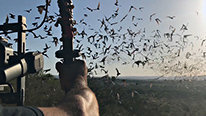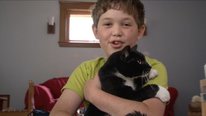- Martha Merson
- Project Director
- Presenter’s NSFRESOURCECENTERS
- TERC
- Louise Allen
- http://www.wssu.edu/profile/dept/bios/allenl/default.aspx
- Visiting Assistant Professor
- Presenter’s NSFRESOURCECENTERS
- Winston-Salem State University
- Nickolay Hristov
- Associate Professor
- Presenter’s NSFRESOURCECENTERS
- UNC Center for Design Innovation, Winston-Salem State University
Choice
iSWOOP-Interpreters and Scientists Working on Our Parks
NSF Awards: 1514776
2017 (see original presentation & discussion)
Grades K-6, Grades 6-8, Adult learners, Informal / multi-age
From designing professional development for park rangers to designing visuals with scientists to engage the public, the iSWOOP project team of Hristov, Allen, and Merson is committed to compelling visualizations that spark interest, interactive learning experiences, and fostering curiosity. iSWOOP partners, park rangers and scientists seek to answer the questions, How do we know what we know - about frog, bats, rocks, and plants over time? During the next three years, several parks will adapt and adopt the iSWOOP approach to communicating science with public audiences. If you visit a national park, ask about the science that is going on behind the scenes. With gratitude to the National Park Service staff for their assistance, spirit of experimentation, and dedication to public service.
Related Content for iSWOOP Designs
-
 2015iSWOOP
2015iSWOOP
Martha Merson
-
 2019iSWOOP--Behind the Lens
2019iSWOOP--Behind the Lens
Martha Merson
-
 2018iSWOOP Transforms
2018iSWOOP Transforms
Martha Merson
-
 2016iSWOOP2.0
2016iSWOOP2.0
Martha Merson
-
 2021Virtual professional development for community educators
2021Virtual professional development for community educators
Sue Allen
-
 2015Cat Safety Invention-Informal Learning Via Engineering
2015Cat Safety Invention-Informal Learning Via Engineering
Marisa Wolsky
-
 2017The use of mobile applications for informal science learning
2017The use of mobile applications for informal science learning
Richard Ferdig
-
 2020Virtual coaching for afterschool educators in rural settings
2020Virtual coaching for afterschool educators in rural settings
Sue Allen



Martha Merson
Project Director
Welcome to iSWOOP where we think visually and creatively about
1) how to make sure park rangers are up to speed on the science happening in their parks
2) how to equip park rangers with stories and images to captivate visitors and
3) how to create a collection of visualizations (a portable, visual library) that will spark discussion about the relevance of park-based research both within and outside park boundaries.
We want high quality unusual visualizations to capture attention, but that sounds like any exhibit designer's goal. What sets us apart? We have to design for something that conveys immediacy, that authentic, an outgrowth if not a direct output from the scientific study, perhaps with an unfinished quality. We're something between a panda-cam and Nova with the express intention of eliciting visitors' observations, speculations, and predictions about bats and birds, changes in plant and animal communities and what might come next.
I'll let Nick, Louise, Tracey, and others chime in. Our take on the various components of the project, how they fit together, and what we're learning at different parks is still evolving. Ask us about professional development, the role of technology, partnerships with scientists--it's all fair game. Just know that this project is 18 months old. Not at a point where we have a lot of data on impact to share beyond what we learned at our pilot site. Evaluator Cindy Char and informal educational researchers Scott Pattison and Monae Verbeke, can say more about what we expect to learn from the roll-out of iSWOOP programs in Acadia and Indiana Dunes this summer.
Pati Ruiz
Pati Ruiz
Dean of Studies, CSHNYC
I really like your goal of engaging visitors in new ways. It seems like the face-to-face interactions are incredibly valuable for all! You also mention the portable visual library - is this something that also exists in a digital space for visitors and non-visitors to preview or view afterwards? Also, are you looking to create an exhibit or a training program or a curriculum (or a combination)? And, how are you able to share the images with visitors, and where?
I really enjoyed seeing the footage you have already captured! It's beautiful!
Martha Merson
Project Director
Hi Patricia,
I'm one of the people who strongly favors the face-to-face interactions. The "i" for Interpreters and Scientists Working on Our Parks is in the lead for a reason. I know rangers can't be everywhere all the time, but I haven't embraced the idea of replacing them with apps.
Anyway, that wasn't exactly your question, was it?
In our pilot we heard visitors were interested in purchasing a DVD with images. We also looked into ways to share digital postcards, but didn't find great options for remote parks where cell service and wifi are scarce. Parks already have larger numbers of Facebook and Instagram followers than our project ever will, so collaborating with the parks' social media folks seems like the way to go. That's where visitors naturally gravitate. They don't need a new name or url to keep track of. Then it's on us to figure out how to share content without giving everything away before an actual visit. I've heard Disney has a great app, reminds me of the viewmaster experience from the 1970's, which allows people to revisit their vacation through images.
You put your finger on one of the challenges--creating a training or infrastructure to support something that will ideally change, be added to and updated on a regular basis. We have a couple guides out for review. 1) Getting ready for iSWOOP describes for a park leader what resources are needed and offers strategies and resources for gaining buy-in from interpreters and high-level administrators; 2) a facilitators' manual for introducing iSWOOP approaches to interpretes, and 3) a participant packet with resources on science storytelling, strategies for using a portable, digital library, and ideas for questions to elicit observations, predictions, and speculation.
Each park is deciding where to share the images with visitors. At Acadia, visitors on certain hikes, those attending the Sunday evening program, and anyone exploring near Jordan Pond House on Thursday afternoons will encounter rangers with an iPad ready to talk about landscape succession. At Indiana Dunes iSWOOP approaches will be integrated into a hike and will complement activities at summer fairs. The rangers will show images and convey information related to Dr. Robert Brodmans' research on amphibians and climate change.
That's a start to answering your questions. Thanks for your interest, Patricia!
Richard Ferdig
Hi Martha: It was great to see this video! I'm not sure if you remember, but we connected at the '16 AISL conference over our shared interest in parks and IRB issues (http://stemforall2017.videohall.com/presentatio...). I'd love to connect with you again to see how our projects could positively impact one another. In the meantime, I appreciated the comment about not replacing rangers with apps. I think our initial work had rangers thinking this was about information delivery for visitors; as we continued in our project, they started to see the value of the tool for them as scientists. Did you experience the same kind of engagement? Did you have both buy-in and resistance? If so, what did you do to help build on buy-in while addressing the resistance? Thanks! Rick
Martha Merson
Project Director
Hi Rick, Yes, I remember you. I always wondered how that IRB process worked out.
I heard endorsements of a new Joshua Tree app from rangers there. The plant id feature was really helpful to rangers getting oriented at a new park. I haven't heard much about engagement as scientists from the interpretive rangers.
I would love to tell you more about the recent conversations I had about brokering science between parks and scientists. I've got some new questions and checklists that are meant to help park staff find a fit for science researchers interested in outreach that is not too ambitious and not too limited. Maybe there's more you could add to the tool that would direct these early conversations to a digital tool that could be a legacy from a research project. Humm, you've got me thinking now.
Richard Ferdig
Martha Merson
Project Director
In terms of resistance, there is some mention of it in the article by me, Allen, Cox, and Hristov in the Journal for Interpretation Research (about roving with a portable, digital library. The article came out in 2016, not sure if it's free online at this point). We did have some resistance to using technology in the cave. There's much more to say about this. Building suspense here.
Richard Ferdig
Hi Martha: we're finishing up this summer but still have 3-4 good months ahead of us in this project and then are obviously hoping to continue in the future. I'd love to connect in the next few weeks to learn more about your work and to talk collaboration. Great job on your project! Best, Rick
Julia Geschke
Really cool - I think it's important (and interesting) to really publicize the research that park scientists are conducting. Sometimes with large organizations like NPS, a lot of the focus can be on recreation and visitor experience and I think a lot of people are interested in learning more about the science side of things. Will this be in the form of an app that park visitors can access, or will the park rangers be the one accessing the information to then share with visitors? Will there be any opportunities for park visitors to engage with the research and contribute with citizen science activities?
Martha Merson
Project Director
Hi Julia, You sound like someone who has worked in parks in the past or do you now? If so, where have you worked? I like the story of how the Park Service used to focus its resources on building roads for scenic drives and now thinks about designing for experiences that are so much more.
One answer to your question about citizen science is, "It's up to the parks and scientists." I would like to see iSWOOP as a jumping off point for visitors. Those who express interest in scientists' research could be offered opportunities for active involvement in data gathering. I do think that what we are doing is arousing and fulfilling a need that is more in line with the casual visitor who is willing to learn a little more, but not quite ready to jump into a citizen science project. If a family is at a park and hears a talk or takes a walk and encounters a ranger with a science story to tell and visualizations to share, and the family expresses a lot of interest, a logical extension would be to offer something more.
The other way I see iSWOOP connecting to citizen science is by focusing attention on the data scientists gather and what their visualizations look like. Rangers actively invite visitors to say what they notice. This is a part of the science process that is less common in many citizen science projects. The public frequently helps in data gathering but not as frequently in the analysis.
Thanks for your comments and questions!
Rowena Douglas
Program Officer; Asst. Executive Director; Director for PD
I would love to see interpreters and scientists working together in similar programs in science museums, zoos, aquariums, etc. Outstanding project!
Martha Merson
Project Director
Hi Rowena,
Thanks for your comment. I know there are pockets of this kind of thing happening. The REVEAL project (OMSI & TERC among other collaborations) comes to mind. Do you mostly see scientists engaged in the exhibit design process and then stepping back? This is much on my mind as iSWOOP will be convening a symposium on Science in the Public Eye: Leveraging Partnerships (January 6, San Francisco, for members of the Society for Integrative and Comparative Biology). Perhaps we should talk more about how to leverage that as an opportunity!
Lisa Samford
Executive Director
I really love this project. I don't think most visitors have any idea that our national parks are living laboratories with SO MUCH research underway. There are so many ways to grow the impact of this wonderful notion to more parks (and other public lands), and to connect visitors with citizen science projects underway. This is a really exciting effort. But, we are pretty early into the project. What have you learned, thus far? In a time when federal funding is uncertain, are you getting any pushback on Park engagement? Are you working specifically to integrate local community organizations or schools into the process?
Martha Merson
Project Director
Lisa, the federal funding scene had me really worried this spring during the hiring freeze. It's still not good. Parks are under-staffed compared to what they were 12 years ago. And yet the front line rangers are eager to do their jobs well and enthusiastically welcome resources and professional development. Administrators recognize how important this cultural moment is and the potential for their fairly neutral sites to be a place where the public gets a chance to talk about the scientific process, facts, revision, etc.
I hope to get back to your question about learning thus far later.
Martha
Lisa Samford
Executive Director
The funding piece is always a struggle. I know that the two national parks in my immediate vicinity rely heavily on their friends/foundation support to supplement federal operational dollars. I've forwarded this to them in case you aren't on their radar.
I know that some 150+ research permits from outside institutions are initiated in GTNP and Y'stone annually. But, I don't know how deeply the parks are engaged in tracking/disseminating that science. Does ISWOOP engage non-Park research partners as well as NPS-driven study?
Martha Merson
Project Director
Hi Lisa,
Yes, we see four different scientist types as candidates for iSWOOP. We have a few different types of collaborations we are exploring--(#1,2, and 4 below; haven't touched #3 yet).
1) scientists from academe or another institution (like a nearby Audubon chapter) conducting research in the parks,
2) park-based resource managers conducting studies,
3) NPS staff from outside the park (Inventory and Monitoring staff, for example), and
4) scientists conducting research outside the parks (maybe for ease of permitting) but highly relevant (same species for example).
Over time I'd like to see parks create an interpreter-friendly way for scientists to share their research. The current annual reporting system is an adequate accountability measure, but those annual reports aren't written at all with an eye to make interpreters' jobs easier in terms of bringing research to the visitors' attention.
Leah Clapman
Wow, having done high school student stories about research in National Parks, wish we had connected sooner! You've done a masterful job with this video and your program. Here are our video story-telling resources - we have a whole STEM storytelling curriculum too. Next year the story prompt will be about technology changing our world - but the National Park experience was so transformational for the students, we'll definitely do something similar in the near future. Thanks!
Louise Allen
Martha Merson
Project Director
Hi Leah,
Thanks for directing me to your vide-story-telling resources. Many possibilities for connection here. Technology is transforming people's experiences of parks, so maybe you don't have to embrace the either/or in this situation. Connecting parks, science, and young people feels like some of the most important work we can do for everyone's sake. It's really interesting to follow the research that is starting to show the positive benefits of time in nature. It's heartening to see many ways young people can get introduced to national parks. I wonder if we'll ever be able to track how these experiences translate into feelings of ownership, an urge to protect them and make them part of their lives.
Sharon Lynch
Beautiful video. I know NPS is under-funded and hope that this video reaches the right people in Washington DC where we have lots of greatly used National Parks, like Rock Creek Park, which I use nearly every day.
Thank you.
Louise Allen
Visiting Assistant Professor
Sharon, Yes funding is always an important part of the equation. We are working with each park to determine how to implement the components of iSWOOP in the way that makes the most sense for the culture of that park. It is our hope with these considerations that iSWOOP or iSWOOP-like activities will be sustained after the life of our grant. It is something that is always on my mind and on the tip of my tongue when talking with NPS staff.
On a national scale we have a number of NPS folks who hold leadership positions as project advisors and we engage them and share these videos with them and their staff in DC. The under-funding and hiring freeze worried us the most earlier this spring as a lot of our partnering sites rely on seasonal staff and we worried that we would have few interps that would be able to participate. The supervisors at each park are really amazing at making it all work with limited resources (people, time and funding).
Further posting is closed as the event has ended.